Introduction
- The use of a Skinner box effectively illustrates behavior of rats in a controlled environment.
- The Skinner box allows the manipulation of feeding behavior of a rat using a positive reinforcement strategy (Sr+).
- A standard Skinner box comprises of a signal (stimulus), a lever (response), and feeder (consequence).
- The experiment seeks to exhibit a positive reinforcement of the feeding behavior of a rat caged in the Skinner box.
Rats exhibit a scavenging behavior when placed in a new environment because they search for food and hiding places. The use of a Skinner box effectively illustrates behavior of rats in a controlled environment. In the Skinner box, it is possible to manipulate the feeding behavior of a rat using a positive reinforcement strategy (Sr+). According to Manabe (2017), a standard Skinner box comprises of a signal, a lever, and feeder. A signal is a stimulus that alerts a rat to press a lever, which is an important behavioral response, to get favorite food from a feeder. The behavior pressing a lever is simple enough for a rat to learn through reinforcement with food but distinguishable from random movements. Therefore, the experiment aims to demonstrate a positive reinforcement of the feeding behavior of a rat caged in the Skinner box.
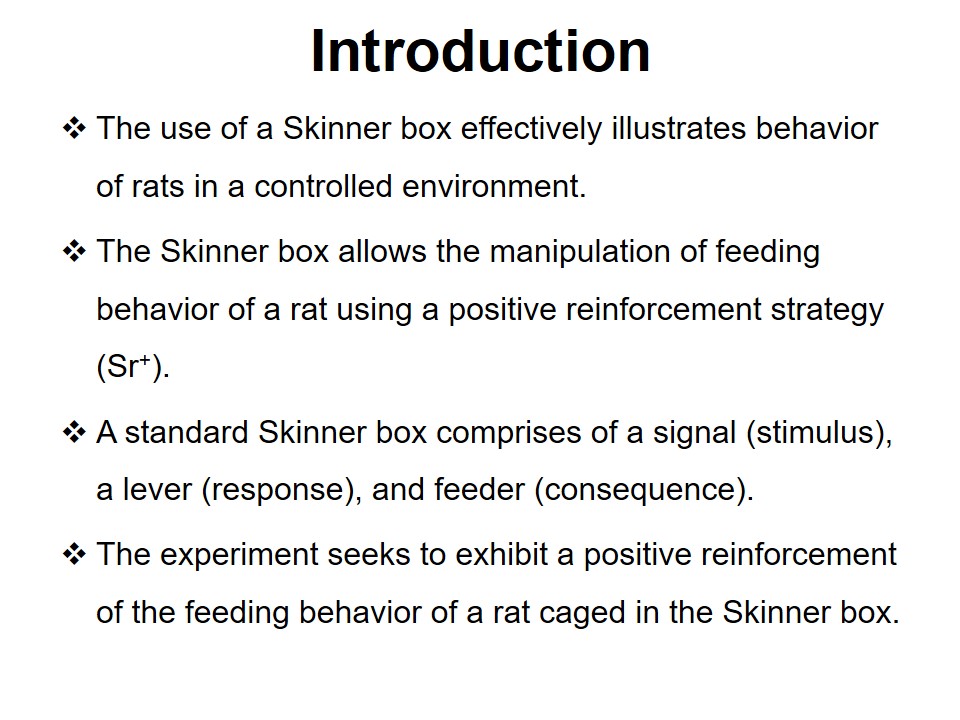
Target Behavior
- The target behavior in the experiment constitutes a lever-pressing action.
- The lever-pressing is an observable, measurable, and repeatable behavior.
- What counted as the target behavior is the pressing of the lever using forelimbs for the feeder to release food.
- What did not count as the behavior is pressing of the lever by the random movement of head and body.
The target behavior in the experiment comprises of a lever-pressing action by the rat to obtain food from the feed in response to the auditory signal. Cooper, Heron, and Heward (2007) assert that the target behavior should be observable, measurable, and repeatable. The lever-pressing is an observable behavior because a rat has to change its posture and exert a considerable for the feeder to release food. Moreover, the lever-pressing is a measurable behavior by the duration it takes to press. The lever-press is a repeatable behavior since a rat performs it continuously so long as it is hungry and seek to access additional food. In the analysis of behavior, what counted as the target behavior is the pressing of the lever using forelimbs for the feeder to release food. In contrast, what did not count as the behavior is pressing of the lever by the random movement of head and body. Therefore, the experiment seeks to increase the behavior of lever-pressing by utilizing food as a positive reinforcer.
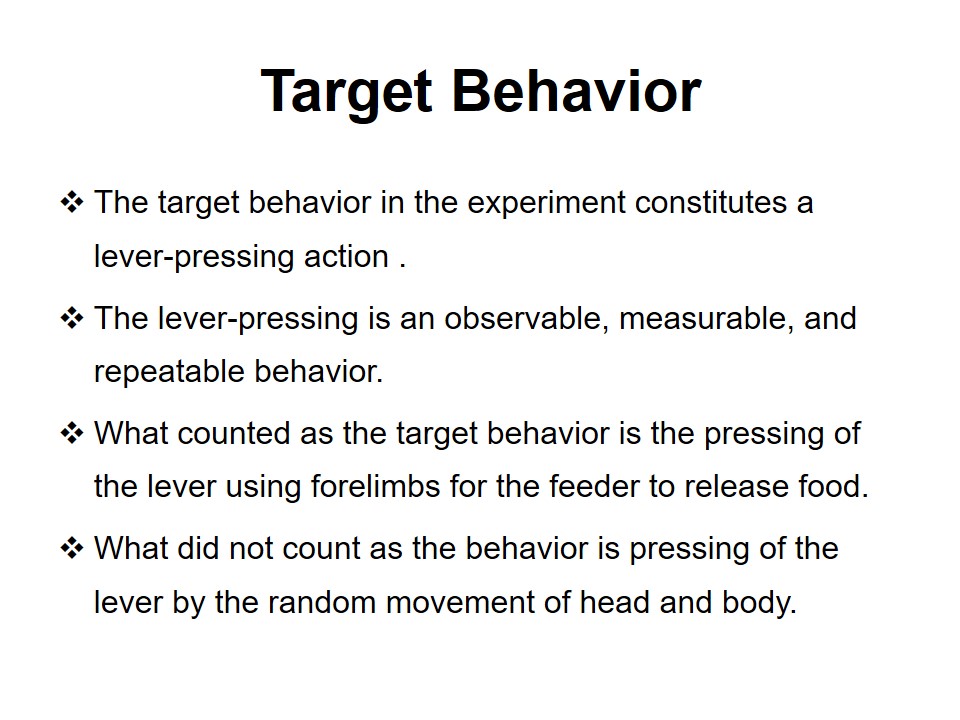
Goal
- The aim is to reinforce the lever-pressing behavior of a rat using its favorite food as a reward.
- The duration and the frequency of response are two measures of evaluating the behavior of the rat.
- The expectation is that the duration of response would decrease with time due to the reinforcement of behavior.
- Another expectation is that the frequency of response would increase due to learning and continuous motivation by food.
The goal of the experiment is to reinforce the lever-pressing behavior of a rat using its favorite food as a reward. The duration and the frequency of response are two measures of evaluating the behavior of the rat in the Skinner box. At the end of the experiment, the expectation is that the duration of response would decrease with time due to the reinforcement of behavior. Additionally, the experiment expects the frequency of response to increase owing to learning and continuous motivation by food. Overall, it is expected that a rat would perfect the way of pressing the lever and obtaining from the feeder efficiently as outcomes of reinforcement and learning.
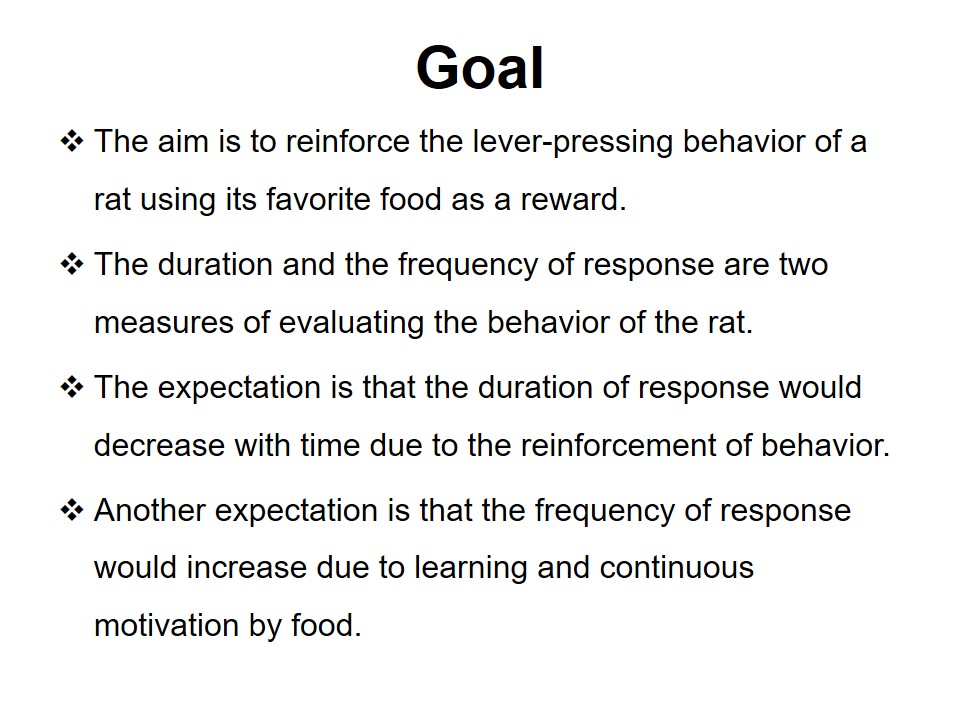
Intervention
- The Skinner box was made in the laboratory and put in a quiet environment.
- Its functions were tested to guarantee that the auditory signal and lever were working well.
- A healthy rat was selected, place in a different residing cage, and then taught how to obtain food in the Skinner box.
- The rat was starved for 24 hours and then kept in the Skinner box for observation.
- The rat was removed from the residing cage and placed in the Skinner box.
- The rat was allowed to settle for five minutes for it to familiarize with the environment.
- Following the auditory signal, the duration and frequency of response was recorded.
- The same protocol was repeated each day for five days to allow the collection of sufficient data.
The Skinner box was set up in the laboratory and placed in a quiet environment, which was free from any form of interruptions. It was tested to ensure that the auditory signal and lever were working well for the rat to exhibit their behaviors effectively. Moreover, the favorite food of the rat was added in adequate amounts to allow the experiment to run into completion without interference during the process. A healthy rat was sampled and kept in a different residing cage, and subsequently taught how to obtain food in the Skinner box by pressing the lever. The rat was starved for 24 hours in the residing cage after which it was placed in the Skinner box where it could respond to the auditory signal, press lever, and access food.
In the first day, the rat was removed from the residing cage and placed in the Skinner box for the experiment to commence. The rat was allowed to settle for five minutes for it to familiarize with the environment and relieve anxiety created during a disturbance. Subsequently, the auditory signal was made and the response time was recorded. Additionally, the frequency of lever-press was recorded during feeding. The rat was then removed and placed in the residing cage to starve for the next day’s experiment. The same protocol was repeated each day for five days to allow the collection of sufficient data and detect the occurrence of reinforcement in the feeding behavior of rats.
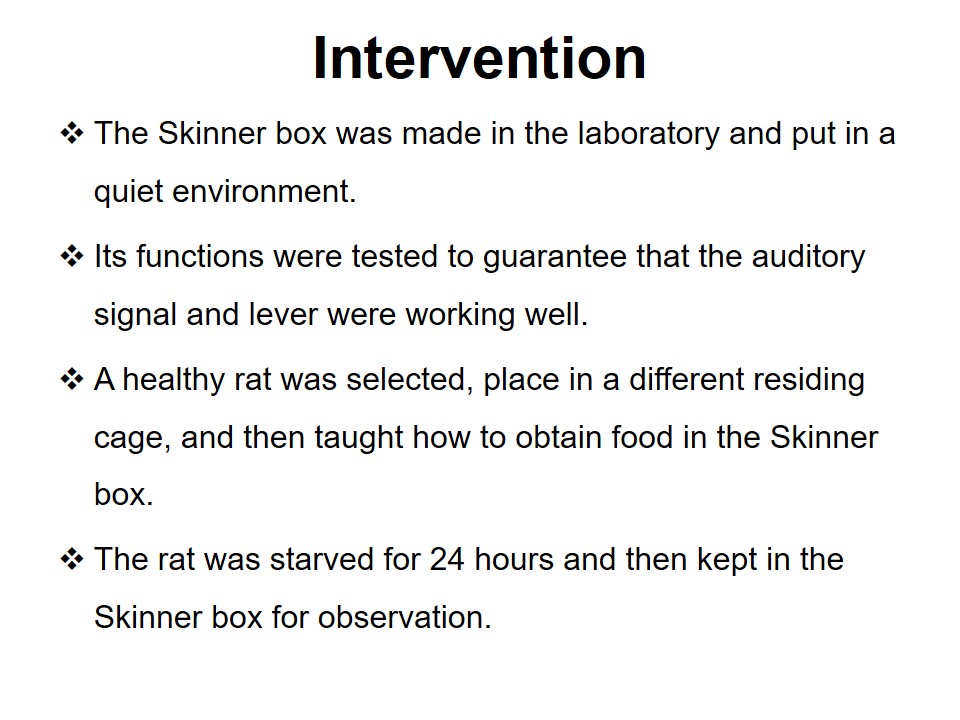
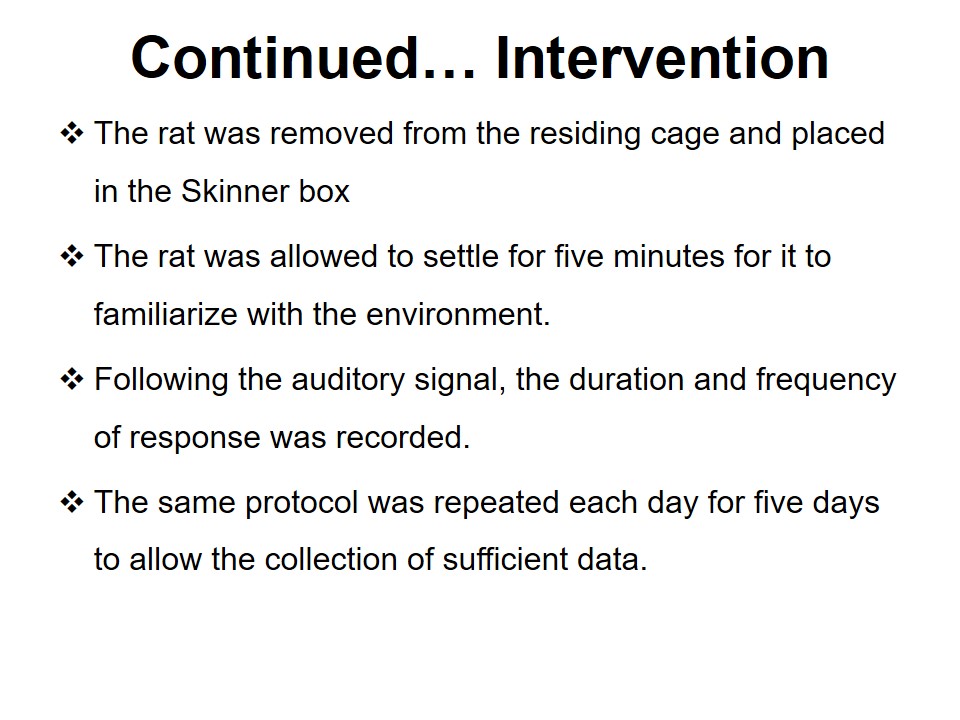
Data Collection
- The process of data collection entailed observation of behaviors and timing of their occurrences.
- Observations were made on the way the rat behaved in the Skinner box and reacted to the auditory signal.
- The duration of response was recorded as the number of seconds it took the rat to respond to auditory signal.
- The response frequency was noted by measuring the number of lever-press in the first 10 minutes of feeding.
The process of data collection entailed observation of behaviors and timing of their occurrences. Observations were made on the way the rat behaved in the Skinner box and reacted to the auditory signal. Since it was expected that the rat would respond to auditory signals by pressing the lever to get food from the feeder, the response duration was measured. The number of seconds it took the rat to respond to auditory signal was recorded as the response duration. Moreover, the response frequency was noted by measuring the number of lever-press in the first 10 minutes of feeding. The duration and frequency of response constituted the key findings collected from the experiment to illustrate the reinforcement of the feeding behavior of the rat.
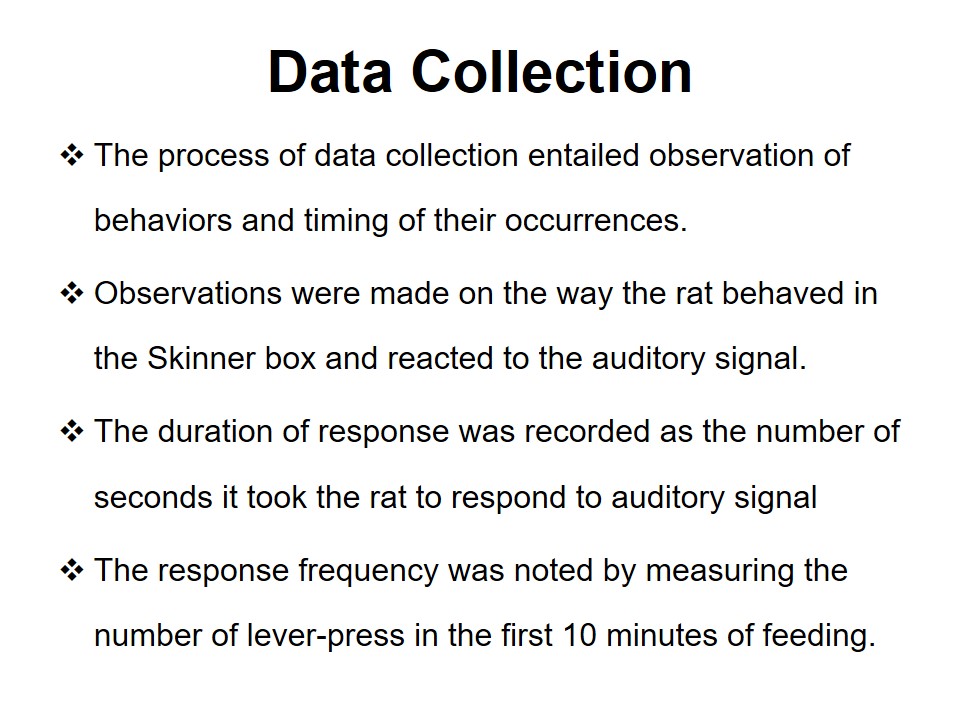
Results
The data for the duration of response of rat in five days were presented in a line graph to illustrate the trend of distribution. The graph shows that the duration of response decreased from 45 seconds on the first day to 15 seconds on the fifth day. The decrease in the duration of response shows that the favorite food managed to reinforce the lever-pressing behavior of the rat. During the first day, the rat took longer to respond to the auditory signal because it was not accustomed to the reward of pressing the lever. However, by the fifth day, the response time decreased significantly due to the effect of reinforcement.
The frequency of responses in the first 10 minutes of feeding was plotted in a line graph to depict the pattern of variation. The graph shows that the frequency of responses increased from 12 on the first day to 45 on the fifth day. The increase in the frequency of responses implies that the feeding behavior of pressing lever increased significantly. Therefore, the finding demonstrates that favorite food is an effective reinforcer of the behavior of pressing lever in rats.
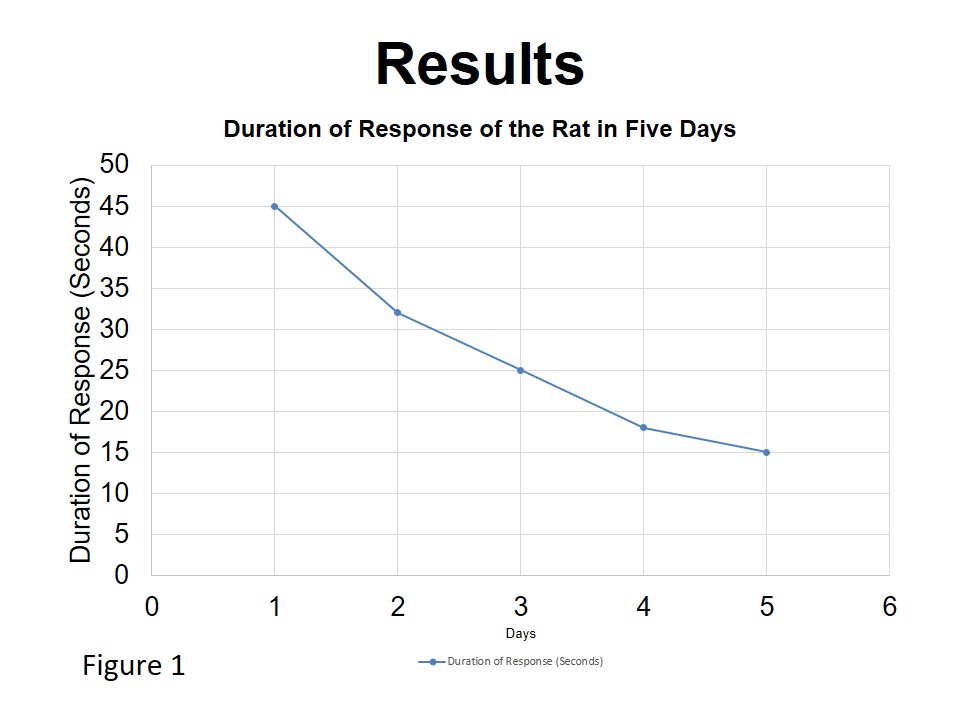
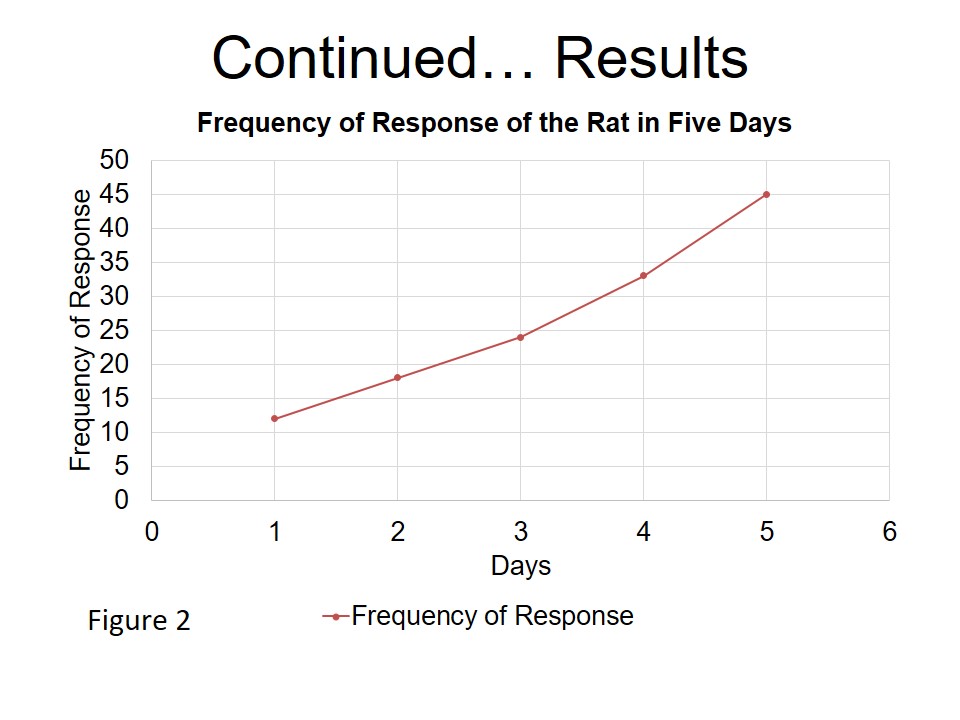
Discussion
- The experiment demonstrated the reinforcing effect of the favorite food on the feeding behavior of the rat.
- The findings illustrate that the duration of response decreased significantly from 45 to 15 seconds.
- The positive reinforcement improves learning and memory skills (Cooper et al., 2007).
- A progressive change in the duration of response exhibit a positive reinforcement (Leslie, 2015).
- Additionally, the experiment demonstrated how favorite food increases the frequency of responses.
- The findings show that the frequency of responses increased progressively from 12 to 45.
- The progressive increase in the frequency of responses reflect the change in the feeding (Sutton & Barton, 2018).
- Food is a reward that provides an additional stimulus to the behavior of pressing the lever in rats.
The experiment used the rat to demonstrate that the favorite food reinforces the feeding behavior of pressing a lever to access food in the Skinner box. The findings illustrate that the duration of response to the auditory signal was 45 seconds on the first day, which gradually decreased to 15 seconds on the fifth day. Cooper et al. (2007) assert that positive reinforcement improves learning and memory skills in both animals and humans. The decrease in the duration of response shows that the favorite food managed to reinforce the lever-pressing behavior of the rat. A gradual change in behavior shows the learning curve of behavior due to the process of positive reinforcement (Leslie, 2015). During the first day, the rat took longer to respond to the auditory signal because it was not accustomed to the reward of pressing the lever. However, by the fifth day, the response time decreased significantly due to the effect of reinforcement. The progress decrease in the duration of responses shows that reinforcement is a gradual process in rats.
The experiment also demonstrated how favorite food increases the frequency of pressing the lever in the first 10 minutes of feeding. The analysis of data depicted that the frequency of responses increased steadily from 12 on the first day to 45 on the fifth day. The increase in the frequency of responses implies that the feeding behavior of pressing lever increased significantly. Sutton and Barton (2018) describe positive reinforcement as the use of an extra stimulus that encourages the adoption of a particular behavior. In this case, the reward of food is the extra stimulus that enhances the behavior of pressing the lever in rats. Therefore, the finding exhibits that the favorite food is an effective reinforcer of lever-pressing behavior in rats.
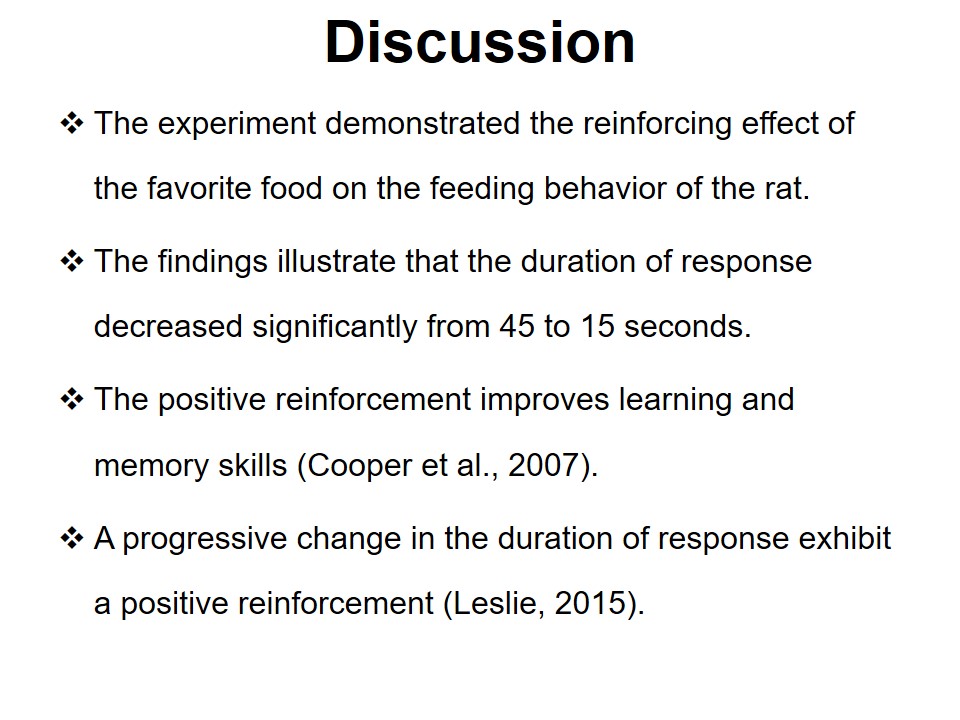
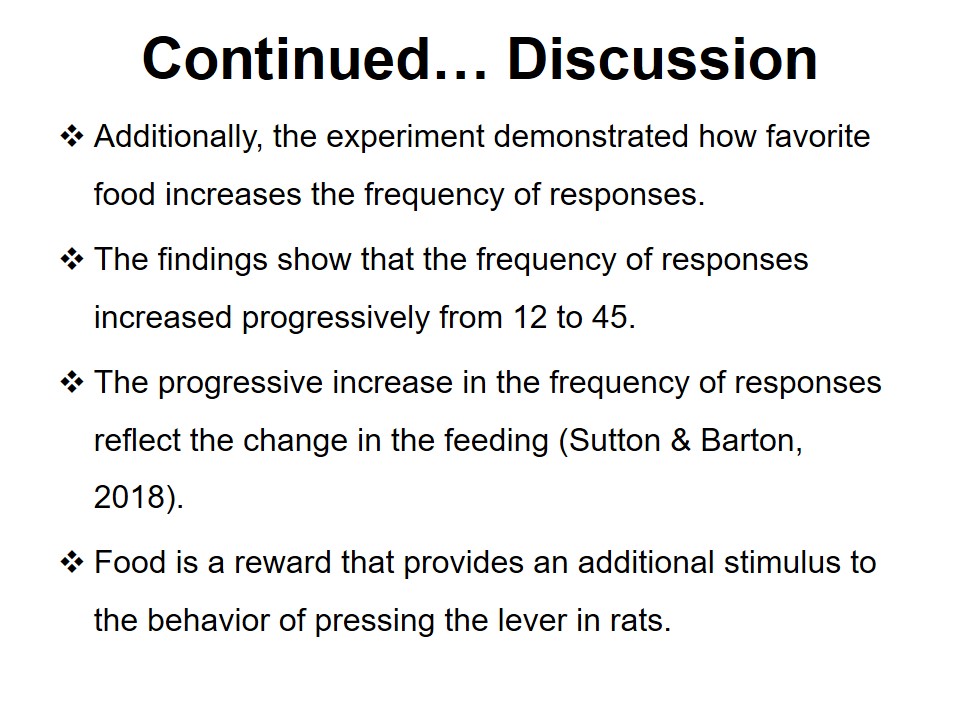
Conclusion
- The experiment selected a healthy rat and used it to demonstrate how positive reinforcement of feeding behaviour occurs.
- Results indicated that the duration of response to the auditory signal decreased steadily.
- Moreover, the findings revealed that the frequency of pressing the lever increased gradually.
- Food effectively reinforced the feeding behaviour of the rat.
The rat was used in the experiment to demonstrate positive reinforcement of feeding behavior of pressing a lever to obtain food. The analysis of results showed that the duration of response to the auditory signal decreased consistently for five days. Additionally, results indicated that the frequency of pressing the lever increased gradually due to learning. Hence, the experiment managed to illustrate that food is an effective reinforcer of the feeding behavior of the rat.
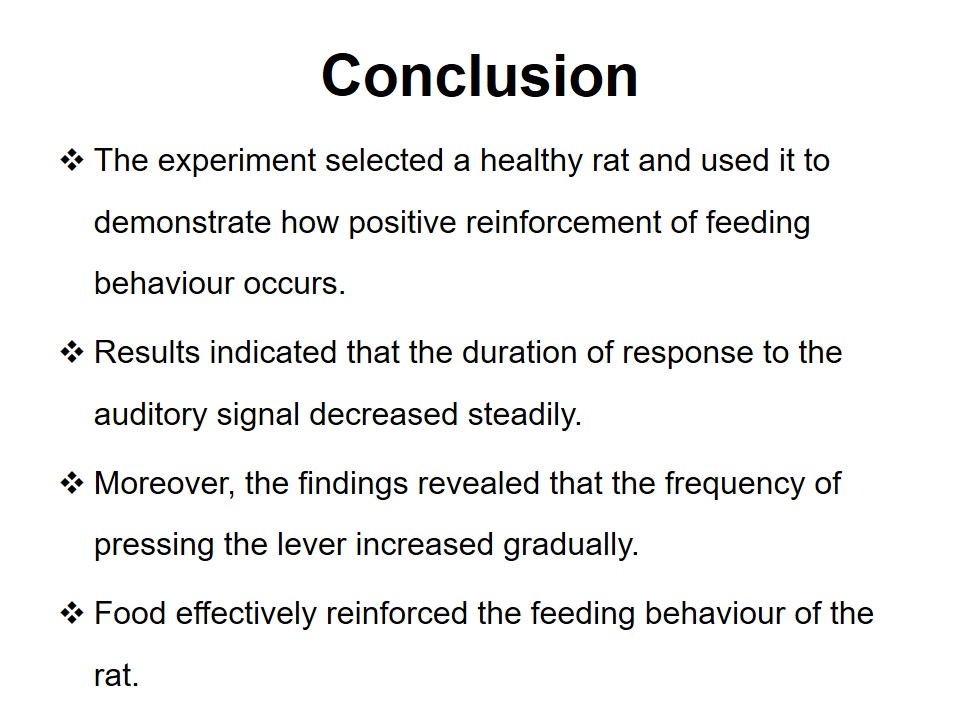
References
Cooper, J.O., Heron, T .E., & Heward, W .L. (2007). Applied behavior analysis (2nd Ed.). Upper Saddle River, NJ: Prentice Hall.
Leslie, J. (2015). Essentials of behavioral analysis. New York, NY: Routledge.
Manabe, K. (2017). The Skinner box evolving to detect movement and vocalization. Mexican Journal of Behavior Analysis, 2(43), 192-211. Web.
Sutton, R. S., & Barton, A. G. (2018). Reinforcement learning: An introduction. Massachusetts, MA: MIT Press.